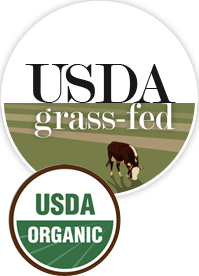How much do you really know about organic vs grass fed?
Do you know the difference between organic vs grass fed? Before you start your 28-Day Micronutrient Miracle journey, we're here to help you understand. Let’s first examine the term grass-fed. Until about a hundred years ago, cows were given a diet restricted to their native food, grass. However, cost-cutting strategies have created feedlots where the cows are fed grains and stale candy (up to seven pounds a day) to hasten their growth and are no longer allowed to feed naturally on grass.
On your expedition, we advocate consuming often elusive grass-fed products because doing so helps avoid Everyday Micronutrient Depleter #2: Unnatural Feed and Environment and because studies show that dairy products from grass-fed cows are better for you. Why? Cows are supposed to eat grass, and when they do, they properly receive all the essential micronutrients and deliver them to you. Grass-fed cows also deliver two fantastic essential fats: CLA, which has cancer-fighting and fat-metabolizing potential, and omega-3, which cools inflammation and is thought to reduce the risk of cancer and cardiovascular disease. The bottom line is that healthy grass-fed cows produce healthy micronutrient-rich meat, milk, cheese, yogurt, and butter. However, the term grass-fed can’t tell us anything more. It begins and ends with what the cattle has been fed. It cannot tell you if the grass the cow is fed is from GMO seeds, if it has been sprayed with pesticides, or if it has been grown using synthetic fertilizer. It also cannot guarantee you that the animal has not been give antibiotics or synthetic hormones. Read grass-fed on the label like this:
When you see organic on a dairy label, it means something altogether different than grass-fed. According to the USDA Organic Production and Handling Standards, the term organic requires that cows be unconfined and allowed to eat grass for the entire grazing season (not less than 120 days) and that at least 30 percent of their feed or dry matter intake must be from grasses. This leaves 70 percent of their food potentially coming from grains. While some studies have shown that organic foods, including dairy products, contain higher levels of micronutrients, there is no guarantee. The true benefit of organic foods is their ability to protect from potentially harmful toxins. Organic cattle receive no synthetic hormones or antibiotics, and the 70 percent of time they are not eating grasses, organic cattle must be given feed that is free of GMOs, pesticides, and synthetic fertilizers. The bottom line is that while purchasing organic meat and dairy products minimizes your toxic load, it does not guarantee the greater micronutrient levels of grass-fed beef and dairy. To get the best of both worlds, look for an option that is both grass-fed and organic.
Now, we know you may be thinking: “This is going to get expensive” or “My local grocery store doesn’t carry any organic, grass-fed meats or dairy items.” We completely understand; our goal is to show you the path to micronutrient sufficiency and make you aware of the safest, most micronutrient-rich choices throughout the grocery store. We are sensitive to budgetary restrictions as well as the fact that many grocery stores are not yet stocking high-quality grass-fed, organic meats and dairy items. However, Costco, Sam’s Club, and other wholesale food clubs; Target; and even Walmart now carry organic and grass-fed options. This is where you have to weigh the choices and use your best judgment.
We often find that people are satisfied with smaller portions of higher-quality, micronutrient-rich meats. This is because, the desire to eat more food often comes not from the fact that we did not ingest enough calories but rather from the hidden hunger for essential micronutrients. As this higher-quality, more micronutrient-rich food fills the body’s requirements for micronutrients faster, less food or smaller portions satiate more fully. Keep that in mind over your 28-day Micronutrient Miracle plan and see if it isn’t true for you. Additionally, don’t forget to add up the cost of all the food items you may typically put into your cart on a weekly basis that are now either eliminated or restricted on your Micronutrient Miracle menu plan, including snacks, cereals, sodas, juices, store-bought desserts, pasta, wine, beer, chips, and bread. Often, you'll find the money you save on these items can more than make up for the difference in price between the conventional beef and dairy products and the grass-fed, organic options.
Ready to learn more about how you can join us for support while on your own Micronutrient Miracle journey? Click here!












